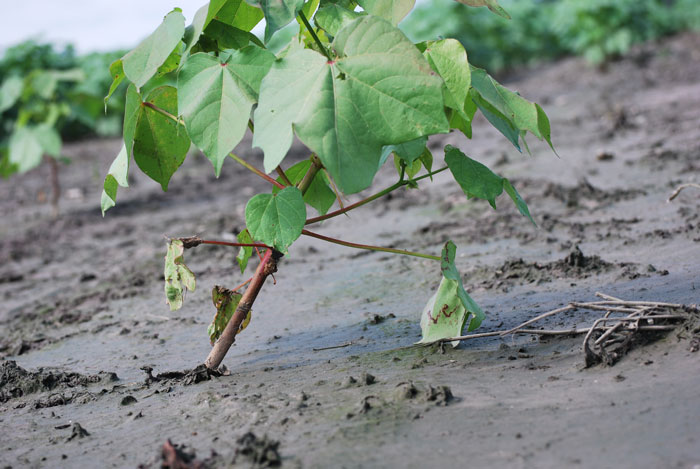
It has been an exceptionally wet spring for much of Texas, perhaps more so for parts of the Texas Coastal Bend, the lower Blacklands and extreme Southeast Texas than most areas. Heavy downpours in March, April and again in May caused severe flooding on the Brazos and Trinity Rivers and caused standing water in fields from Harris County south to Nueces County and adjacent areas all along the coastal plains and north into the lower Blacklands region.
Now that fields are beginning to dry, crop damage from rain events and floodwaters are becoming evident in many fields, especially in cotton and corn (sporadically) all along the affected coastal corridor.
In recent crop update reports, Dr. Gaylon Morgan, Professor and Extension state cotton specialist at Texas A&M in College Station, is reporting widespread yellow cotton in the Coastal Bend as the crop was loaded with squares and approaching the early bloom stage. Morgan reported yellowing symptoms are more prevalent in the poorly drained fields where the soil has remained saturated for 5 to 10 days.
"The heavy clay soils in these regions are the lifeblood of crop production because of high water and nutrient holding capacity. However, these soils also drain slower and excessive rain can lead to prolonged saturated and anaerobic soil conditions," he said.
In addition to yellowing in cotton, Dr. Thomas Isakeit, Professor and Extension Plant Pathologist at Texas A&M in College Station, is reporting Southern rust of corn (Puccinia polysora) present in fields in several Upper Coast counties. He warns that rust has the potential to cause yield loss in susceptible hybrids, and growers should be scouting for it in their fields.
SOUTHERN RUST IN CORN
Southern rust is the most important foliar disease of corn in the Upper Coast region of Texas. In some wetter years, susceptible hybrids may require fungicide treatments to minimize yield loss.
The symptoms of this disease are slightly raised, circular (1 to 2 millimeter diameter), orange pustules mainly on the upper sides of leaves. Southern rust pustules can also occur on stalks and husks. Initially, southern rust occurs on the lower foliage and progresses to the upper canopy during the growing season. Disease severity in the upper canopy is increased by wet conditions (frequent rain) during the season.
For more information about Southern rust and treatment options, producers should visit http://aglifesciences.tamu.edu/plantpathology/wp-content/uploads/sites/19/2011/05/Southern-Rust-of-Corn_2014.pdf.
"I have frequently encountered common rust (Puccinia sorghi) this season. This is not a disease of concern in Texas. Northern leaf blight is present in many areas as well, but this is also not a problem except for very susceptible hybrids," Isakeit added.
DEALING WITH YELLOW COTTON
Morgan says yellow cotton was widespread across the Coastal Bend of Texas as the crop was loaded with squares and approaching the early bloom stage the last week of May and into early June. The yellowing symptoms are more prevalent in poorly drained fields where the soil has remained saturated for 5 to 10 days.
"At the current growth stage, the cotton plants have a tremendous nutrient uptake demand, and simultaneously poor conditions for nutrient uptake into the roots. In most fields, the upper cotton canopy was yellow, while the lower canopy was greener," Morgan says.
Nitrogen, Phosphorous, Potassium, Magnesium, and some other nutrients, are plant mobile and will move from older leaves to newer leaves when insufficient nutrients are available. As a result, N,P, K, and Mg, deficiency symptoms occur on the older leaves of the plant first. Calcium, Sulfur Iron, Zinc, Boron, and some others, are immobile in the plant. Morgan explains that as a result, nutrient deficiency symptoms of immobile nutrients occur first in upper leaves, which he says is the current situation in the Coastal Bend.
(Specific nutrient deficiencies in cotton can be viewed at IPNI’s webpage)
"Based on previous experience and conversations with people familiar with the Coastal Bend, I would expect the nutrient deficiency symptoms to disappear as the soils dry, oxygen re-enters the soil, and nutrient uptake resumes. Then, nutrient uptake will sufficiently supply the plant needs for mobile and immobile nutrients," Morgan said.
The level of yield loss due to the insufficient supply of nutrients is hard to predict, he warns, and will continue to be affected by growing conditions the remainder of the season.
"If producers feel the need to try to manage the situation, I suggest collecting some leaf samples from the upper leaves in yellow areas of the field and submit them to a laboratory to identify nutrient levels. Then, foliar applications of the limited nutrient(s) could be applied, if necessary," he added.
ADDITIONAL CONCERNS FOR COTTON
In addition to yellow cotton in the Coastal Bend, Isakeit says some corn producers in the Blacklands have reported leaf spots on lower leaves of cotton. He says although symptoms resemble Ascochyta blight, also known as wet weather blight, examination under a microscope has revealed only Phyoma species.
"In addition to Phoma leaf spot, in one field I found a few plants with petiole and stem lesions. The anthracnose fungus (Colletotrichum gossypii) was associated with these lesions, as confirmed with a microscopic examination. These lesions are brittle and break easily," Isakeit said.
Appearance of these cotton diseases has been associated with frequent, rainy weather he explains, and says it appears that with warm, dry weather, the cotton plant generally outgrows the fungus.
"In one field, I did a fungicide application (two active ingredients) on some rows and after four days, I did not see any difference between the treated and non-treated rows. During this time there were some clear, warm days and new and upper leaves of all plants looked good. There may be a problem with stand in some fields where anthracnose is present, but the Phoma leaf spot should not be a long-term problem," he says.
About the Author(s)
You May Also Like




